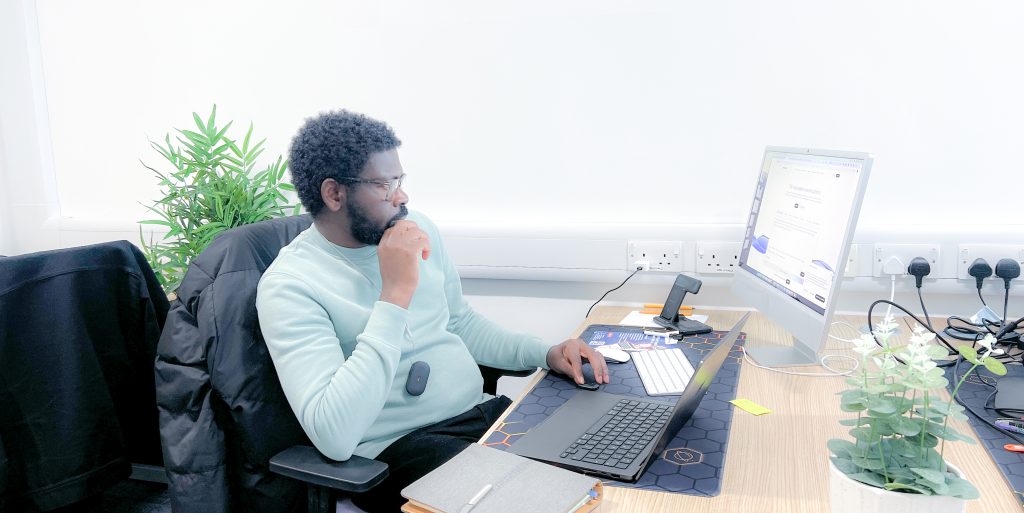
User-centered design: Creating exceptional digital experiences is an art and a science. At the heart of this endeavor lies the User Experience (UX) roadmap, a strategic guide that directs your journey toward crafting user-centered designs. Whether you’re an aspiring UX designer or a seasoned professional, understanding and implementing a UX roadmap ensures that you deliver products that resonate with users, providing value and fostering loyalty.
The UX roadmap is not merely a checklist but a dynamic framework that adapts to the project’s needs, market demands, and user feedback. It’s the compass that ensures your designs are both effective and engaging. By following a structured approach, you can navigate the complexities of user behavior, technology, and design principles to create products that users love and trust.
Embarking on the UX roadmap begins with a deep dive into research and discovery. This phase is crucial because it sets the stage for everything that follows. It involves understanding your target users, their needs, preferences, and pain points.
User Research
Conduct various forms of user research, such as surveys, interviews, and focus groups. The goal is to gather qualitative and quantitative data that offer insights into user behaviors and expectations. This data serves as the cornerstone for creating user-centered designs. Effective user research reveals what users want and why they want it, helping you to align your designs with real user needs.
Competitive Analysis
Analyze your competitors to identify industry standards and uncover opportunities for differentiation. By understanding what your competitors offer and where they fall short, you can find unique angles to address user needs more effectively. Competitive analysis enriches your UX roadmap by highlighting trends and gaps that your design can leverage.
Stakeholder Interviews
Engage with stakeholders to gather their perspectives and expectations. Stakeholders can provide valuable insights into business goals, technical constraints, and user requirements. Their input helps shape the UX roadmap, ensuring that it aligns with both user needs and business objectives.
Once you’ve gathered your data, it’s time to define the key aspects of your project. This phase involves synthesizing research findings to create a clear vision and strategy for your user-centered designs.
User Personas
Create detailed user personas based on your research. Personas are fictional yet data-driven representations of your target users. They help you empathize with your audience and make informed design decisions. Each persona should include demographics, goals, frustrations, and behaviors, providing a comprehensive understanding of who your users are.
Problem Statements and Goals
Define problem statements that articulate the challenges users face. These statements should be specific and actionable, guiding your design process. Alongside problem statements, set clear goals for your project. What do you aim to achieve? How will your design solve user problems? Goals provide direction and metrics for success on your UX roadmap.
Value Proposition
Craft a compelling value proposition that outlines the unique benefits your design offers. A strong value proposition differentiates your product in the marketplace and highlights why users should choose it over competitors. This clarity is vital for guiding design decisions and ensuring that your product meets user needs effectively.
With a defined course, the UX roadmap leads you to the ideation phase, where creativity flourishes. This stage is about generating ideas and exploring various solutions to the problems identified earlier.
Brainstorming
Engage in brainstorming sessions with your team to generate a wide range of ideas. Encourage free thinking and avoid immediate judgment of concepts. The goal is to explore as many possibilities as possible, fostering innovation. Document all ideas, no matter how unconventional, as they might inspire future solutions.
Sketching and Wireframing
Translate your ideas into sketches and wireframes. Sketching allows for quick visualization of concepts, while wireframes provide a more structured representation of your designs. Wireframes outline the layout, functionality, and user flow without focusing on visual details. They serve as blueprints, guiding the development of more detailed designs later in the UX roadmap.
Storyboarding
Create storyboards to illustrate how users will interact with your product. Storyboarding combines visuals and narratives to depict user scenarios, helping you understand the context in which your design will be used. This technique ensures that your solutions are user-centered and aligned with real-world applications.
Prototyping is where your ideas begin to take shape. This phase of the UX roadmap involves creating interactive models of your design to test and refine concepts.
Low-Fidelity Prototypes
Start with low-fidelity prototypes, such as paper sketches or simple digital mockups. These prototypes are quick and inexpensive to produce, allowing you to explore different ideas and gather initial feedback. Low-fidelity prototypes focus on functionality and user flow rather than visual aesthetics.
High-Fidelity Prototypes
Progress to high-fidelity prototypes as your design evolves. These prototypes are more detailed and closely resemble the final product. They include visual design elements, interactive features, and realistic user interactions. High-fidelity prototypes are valuable for usability testing and stakeholder presentations, providing a clearer vision of the final design.
Usability Testing
Conduct usability testing with real users to evaluate the effectiveness of your prototypes. Usability testing identifies issues and areas for improvement, ensuring that your design is intuitive and user-friendly. Collect feedback, observe user interactions, and iterate on your prototypes based on the insights gained.
With validated prototypes, the UX roadmap now guides you to the design phase, where you create the final user interface and experience.
Visual Design
Develop the visual design of your product, including color schemes, typography, imagery, and layout. Visual design enhances the aesthetics and usability of your product, creating a visually appealing and cohesive experience. Pay attention to branding elements to ensure consistency with your company’s identity.
Interaction Design
Design the interactions and animations that users will experience. Interaction design focuses on how users will navigate and interact with your product, ensuring that it is intuitive and engaging. Consider factors such as feedback mechanisms, transitions, and interactive elements that enhance the overall user experience.
Accessibility
Ensure that your design is accessible to all users, including those with disabilities. Accessibility is a critical aspect of user-centered designs, promoting inclusivity and compliance with legal standards. Implement features such as keyboard navigation, screen reader compatibility, and high-contrast modes to make your product usable for everyone.
The development phase of the UX roadmap involves translating your designs into a functional product. Collaboration between designers and developers is crucial to ensure that the final product aligns with the design vision.
Design Handoff
Prepare a detailed design handoff for developers, including specifications, assets, and guidelines. Effective communication during this phase ensures that developers understand the design intentions and can implement them accurately. Use design collaboration tools to streamline the handoff process and maintain alignment.
Front-End Development
Work closely with front-end developers to build the user interface. Ensure that the implementation matches the design specifications and provides a seamless user experience. Regular reviews and feedback sessions help catch discrepancies early and maintain quality.
Quality Assurance
Conduct thorough quality assurance testing to identify and fix any issues. QA testing ensures that the product functions correctly, meets design standards, and delivers a positive user experience. Address usability issues, performance concerns, and compatibility problems to achieve a polished final product.
With the product developed and tested, the UX roadmap leads you to the launch phase. This is the moment when your design is introduced to users and the market.
Beta Testing
Conduct beta testing with a select group of users before the full launch. Beta testing provides valuable feedback and helps identify any last-minute issues. Use this feedback to make final adjustments and ensure that the product meets user expectations.
Marketing and Communication
Develop a marketing strategy to promote your product. Effective communication highlights the value proposition and key features, attracting users and generating interest. Use various channels such as social media, email campaigns, and product demos to reach your target audience.
Monitoring and Support
Monitor the product’s performance post-launch and provide support to users. Collect feedback, track usage metrics, and address any issues that arise. Continuous monitoring ensures that your product remains user-centered and evolves based on user needs and market trends.
The journey on the UX roadmap doesn’t end with the launch. Iteration is an ongoing process that involves refining your product based on user feedback and changing requirements.
User Feedback
Gather and analyze user feedback to identify areas for improvement. User feedback provides insights into how your product is used, what users like, and what challenges they face. Use this information to prioritize updates and enhancements.
Continuous Improvement
Implement a continuous improvement process to keep your product relevant and effective. Regularly update your design and functionality to address emerging trends, technologies, and user needs. A commitment to continuous improvement ensures that your product remains competitive and user-centered.
Performance Metrics
Track performance metrics to evaluate the success of your product. Metrics such as user engagement, conversion rates, and retention provide quantitative data on how well your product meets user needs. Use these metrics to inform future iterations and strategic decisions.
The UX roadmap is a vital tool for creating user-centered designs that delight and engage users. It provides a structured approach to navigating the complexities of UX design, from research and ideation to development and iteration. By following this roadmap, you ensure that your designs are grounded in user needs, aligned with business goals, and adaptable to changing demands.
User-centered design is an ongoing journey that requires dedication, creativity, and empathy. The UX roadmap serves as your guide, helping you stay focused, innovative, and user-centric. Embrace this roadmap to create experiences that not only meet user expectations but exceed them, fostering loyalty and driving success in an ever-evolving digital landscape.
The ability to adapt and innovate is paramount. The UX roadmap is not just a static plan but a living document that evolves with the project and its users. It begins with comprehensive user research, where designers gather insights into user behaviors, preferences, and pain points. This foundational step ensures that every subsequent decision is informed by real user data, rather than assumptions. The UX roadmap then guides designers through the ideation phase, encouraging creativity while maintaining a clear focus on user needs.
Ideation, as guided by the roadmap, is a critical phase where potential solutions are brainstormed and explored. It is a space for creativity and innovation, yet it remains tethered to user research findings, ensuring that all ideas are relevant and viable. The roadmap aids in prioritising these ideas, aligning them with business goals and technical feasibility, thereby streamlining the decision-making process.
As the project progresses into the development phase, the UX roadmap continues to serve as an invaluable reference. It ensures that the design vision is consistently communicated to developers and other stakeholders, fostering collaboration and coherence. This phase is where the abstract concepts and wireframes begin to take tangible form, and the roadmap ensures that this transition is smooth and aligned with the overall strategy.
Iteration is another critical component of the UX roadmap. In the fast-paced digital landscape, user preferences and technological capabilities are constantly evolving. The roadmap incorporates feedback loops that facilitate continuous testing and refinement of the design. By regularly revisiting and updating the design based on user feedback and analytics, designers can ensure that the final product remains relevant and effective.
Moreover, the UX roadmap emphasises the importance of empathy throughout the design process. Understanding and prioritising the user’s perspective not only leads to more intuitive and satisfying experiences but also fosters a deeper connection between the user and the product. This empathetic approach can significantly enhance user loyalty and trust, which are crucial for long-term success.
In addition to user focus, the UX roadmap also ensures alignment with business objectives. It bridges the gap between user needs and business goals, helping to justify design decisions and investments. By demonstrating how user-centered design can drive business outcomes, the roadmap facilitates buy-in from stakeholders and secures the necessary resources for successful implementation.
Ultimately, the UX roadmap is a strategic asset that empowers design teams to navigate the complexities of UX design with confidence and clarity. It is a tool that brings structure to creativity, ensuring that every design choice is purposeful and impactful. By embracing the UX roadmap, organisations can create products that not only meet but exceed user expectations, fostering engagement and loyalty in a competitive market.
In conclusion, the UX roadmap is essential for creating user-centered designs that resonate with users and achieve business goals. It provides a structured approach to the intricate process of UX design, from initial research to final iteration. By following this roadmap, designers can stay focused, innovative, and user-centric, ultimately delivering experiences that delight users and drive success in an ever-changing digital landscape. Embrace the UX roadmap as a guiding tool to create exceptional, user-centered designs that stand the test of time.




